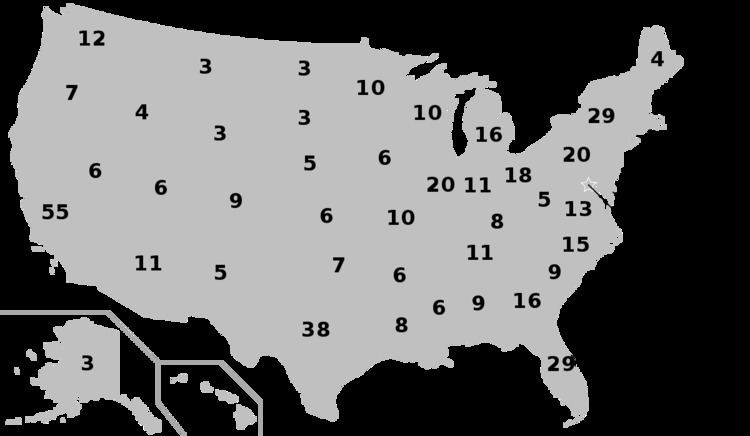November 3, 2020 2024 → Location United States of America | Date 3 November 2020 | |
 | ||
Other Instances United States presidenti, United States presidenti, United States presidenti, United States presidenti, United States presidenti | ||
The United States presidential election of 2020, scheduled for Tuesday, November 3, 2020, will be the 59th quadrennial U.S. presidential election. Voters will select presidential electors who in turn will either elect a new president and vice president through the electoral college or re-elect the incumbents. The series of presidential primary elections and caucuses are likely to be held during the first six months of 2020. This nominating process is also an indirect election, where voters cast ballots selecting a slate of delegates to a political party's nominating convention, who then in turn elect their party's presidential nominee.
Contents
- Procedure
- Demographic trends
- Simultaneous elections
- Advantage of incumbency
- General election polling
- Republican Party
- Candidates who have publicly expressed interest
- Speculative candidates
- Declined to be candidates
- Potential convention sites
- Statewide polling
- Declared candidates
- Speculative Candidates
- References
Barring any major change in circumstances, Republican Donald Trump, who was elected in 2016, will be eligible to seek re-election. The winner of the 2020 presidential election is scheduled to be inaugurated on January 20, 2021.
Procedure
Article Two of the United States Constitution states that for a person to be elected and serve as President of the United States the individual must be a natural-born citizen of the United States, at least 35 years old and a United States resident for at least 14 years. Candidates for the presidency typically seek the nomination of one of the various political parties of the United States, in which case each party develops a method (such as a primary election) to choose the candidate the party deems best suited to run for the position. The primary elections are usually indirect elections where voters cast ballots for a slate of party delegates pledged to a particular candidate. The party's delegates then officially nominate a candidate to run on the party's behalf. The general election in November is also an indirect election, where voters cast ballots for a slate of members of the Electoral College; these electors then directly elect the President and Vice President.
Demographic trends
The age group of what will then be persons in the 18 to 45-year-old bracket is expected to represent 40 percent of the United States' eligible voters in 2020.
Simultaneous elections
The presidential election will occur at the same time as elections to the Senate and the House of Representatives. Several states will also hold state gubernatorial and state legislative elections. Following the election, the United States House will redistribute the seats among the 50 states based on the results of the 2020 United States Census, and the states will conduct a redistricting of Congressional and state legislative districts. In most states, the governor and the state legislature conduct the redistricting (although some states have redistricting commissions), and often a party that wins a presidential election experiences a coattail effect that also helps other candidates of that party win election. Therefore, the party that wins the 2020 presidential election could also win a significant advantage in the drawing of new Congressional and state legislative districts that would stay in effect until the 2032 elections.
Advantage of incumbency
An incumbent President seeking re-election usually faces no significant opposition during their respective party's primaries, especially if they are still popular. For Presidents Ronald Reagan, Bill Clinton, George W. Bush and Barack Obama, for example, their respective paths to nomination became uneventful and the races become merely pro forma; all four then went on to win a second presidential term. Serious challenges are rare, but then generally presage failure to win the general election in the fall. During the 1976 Republican Party primaries, then-former California Governor Reagan carried 23 states while running against incumbent President Gerald Ford; Ford then went on to lose the presidential election to Jimmy Carter. Senator Ted Kennedy then carried 12 states while running against Carter during the 1980 Democratic Party primaries; Reagan then defeated Carter in the fall of 1980. Pat Buchanan captured a decent percentage of a protest vote against George H. W. Bush during the 1992 Republican primaries, but only received a handful of delegates; Bush too subsequently went on to lose in the general election to Clinton.
General election polling
Republican Party
Donald Trump is eligible to run for re-election and has implied that he intends to do so. On January 20, 2017 at 5:11 PM, he submitted a letter as a substitute of FEC Form 2, for which he had reached the legal threshold for filing, in compliance with the Federal Election Campaign Act.
Below are other Republican candidates that may or will run in 2020:
Candidates who have publicly expressed interest
Candidates in this section have expressed an interest in running for President within the last six months.
Speculative candidates
Declined to be candidates
Potential convention sites
Candidates who have publicly expressed interest
Candidates in this section have expressed an interest in running for President within the last six months.
Speculative candidates
Declined to be candidates
Potential convention sites
Statewide polling
Iowa
Declared candidates
Candidates who have publicly expressed interest
Candidates in this section have expressed an interest in running for President within the last six months.
